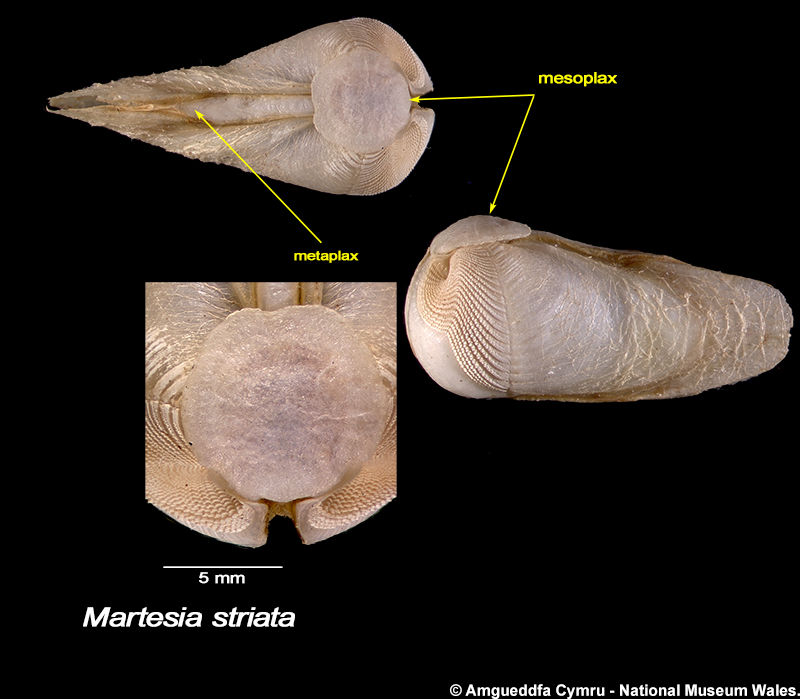Martesia striata (Linnaeus, 1758)
Pholadoidea : Pholadidae | Non-native |
| Tebble name: | Martesia striata Linnaeus |
| Smith & Heppell name: | Martesia striata Linnaeus |
To size: To 50mm. Shell Structure: Main body robust but brittle; posterior extension fragile. Equivalve: Equivalve. Equilateral: Inequilateral beaks close to the anterior. Tumidity: Tumid, especially across the umbos. Outline: Main body subovate, posterior extension narrower and may be irregular; anterior broadly rounded with initial pedal gape filled by the callum. Umbonal reflection covered by a large subcircular mesoplax; dorsal area behind mesoplax covered by a long lanceolate metaplax; posterior ventral region covered by a long lanceolate hypoplax. Contour: Main body of shell divided by a radial groove; posterior extension distinctly demarcated.
Sculpture: Area anterior of radial groove decussate; posterior area with weak concentric ridges; posterior extension with strong growth stops. Ligament: Small. Pallial Musculature: Apophysis long, thin; pallial sinus very deep; anterior adductor scar on umbonal reflection, posterior adductor scar large close to dorsal margin, siphonal muscle scar large in a vertical orientation; accessory ventral adductor scars on either side of condyle. Periostracum: Straw coloured, thin. Colour: Dirty white. Additional Characters: Shells of same species can vary and the most consistent species identifying character is the shape and design of the mesoplax, even in juvenile specimens. In M. striata the mesoplax is large, circular with irregular furrows or wrinkles. The mesoplax can be very variable but is separable from fragilis by lack of concentric sculpture.
Distribution & Ecology
A wood borer, primarily a warm temperate to tropical species recorded rarely from British waters. in Dorset, Brixham, Devon and off Irish counties Sligo and Clare.
Depth Range
Intertidal

Additional Information & Related Species
Related Species
Pholadoidea : Pholadidae
References
Listed are literature citing Martesia striata (Linnaeus, 1758). Reference containing the species Type Description is highlighted.
|
Holmes, A., Fenwick, D., Ganey, P. & Williams, T. 2015. Martesia fragilis Verrill & Bush, 1898 in the North-east Atlantic. OVerlooked and a recent new discovery. Journal of Conchology. 42 (2): |
|
Linnaeus C 1758. Systema Naturae. Editio decima. 1. Regnum Animale Holmiae, Laurentii Salvii. 824pp. |
Resources
- Conchological Society
of Great Britain & Ireland
Provides resources for understanding, identifying, recording, and conserving molluscs - CLEMAM
Check List of European Marine Mollusca - MarLIN
The Marine Life Information Network for Britain and Ireland (MarLIN) provides information for marine environmental management, protection and education. It is a centre of excellence in spatially based and time-series marine biological information and supports good stewardship in the marine environment. - NBN Gateway
National Biodiversity Network's Gateway. Use it to explore UK biodiversity data, as contributed by participating data providers. - BivAToL
- MarBEF
- Malacological Society
- Unitas Malacologica
- Census of Marine Life
- MarBEF
MarBEF, a network of excellence funded by the European Union and consisting of 94 European marine institutes, is a platform to integrate and disseminate knowledge and expertise on marine biodiversity, with links to researchers, industry, stakeholders and the general public.









